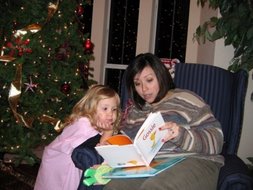Grimes, Nikki. Terry Widener, illus. 2000.
Shoe magic. New York: Orchard Books.
Shoe Magic is a collection of poetry by the celebrated African American children's poet, Nikki Grimes. This book of sixteen poems begins with a rhyme about the shoe rack and ends, most appropriately, with a poem about slippers. These imaginative stanzas support the idea that the shoes make the person, in this case offering a new way to think about footwear. Grimes' makes the connection between shoes and life, encouraging children to explore their passions as future possibility. The colorful illustrations by Terry Widener perfectly depict the verse. Overall this is an attractive collection for the very young through elementary aged children.
The majority of poems found here are short rhyming verses that are straightforward in their meaning. The images presented are concrete making them easy to understand. Grimes infuses interest by interjecting multicultural elements including names such as Talisha, Salena, Lu and Yu. Through these details she breaks cultural stereotypes like in the poem "Talisha's Toe Shoes." Talisha dreams of becoming a ballerina, but she is acutely aware that she does not look like other ballerinas, "They scowl at me,/Determining/That I don't fit the norm" (Grimes 12). Despite this, she is confident that she will live her dream to dance in
The Nutcracker and not only dance, but also blow people away with her talent, "My arabesque/Will be so fine/They'll redefine the word" (Grimes 12). Gender stereotypes are also challenged in the poem "Cleats" where Clarice dreams of being a football player even though she is a girl, "But the cleats don't care/If the socks I wear/Are fuchsia/And my real name is/Clarice" (Grimes 8).
Another characteristic of the poems is humor. Brandi is trying to figure out why her mother had her baby shoes bronzed. She decides that it is for one of two reasons. The first is for them to serve as a reminder that she is no longer a child, they become inspiration for her to grow. The other reason is not so positive, "Lucky for the rest of me/She ran out of bronze" (Grimes 18). Grimes' words are clever mimicking the smart, but playful response any observant child might provide.
Terry Wilder perfectly compliments the poetry with his fanciful artwork. Colorful and eye-catching, his depiction of these children is slightly out of balance, making it all the more interesting to look at. Limbs or objects are not drawn to scale creating a cartoonish quality to the illustrations. However, they are all appealing and pleasing. They contain a playful energy that generates curiosity. The poems sometimes take up a white page opposite the illustrations, at other times the words are printed right on top of the artwork. Either way, the pictures perfectly depict the subjects of the poems supporting the verses without overpowering them.
Grimes' short poems paired with Wilder's vivid artwork has created an excellent collection to browse and read out loud. Even younger children may enjoy listening to the rhyme absorbing the images presented. Older children may appreciate the perspective, recognizing how shoes can sometimes do magic simply by changing who you are. Though this change may only be temporary, it is the feeling you get when wearing the shoes that lasts.
